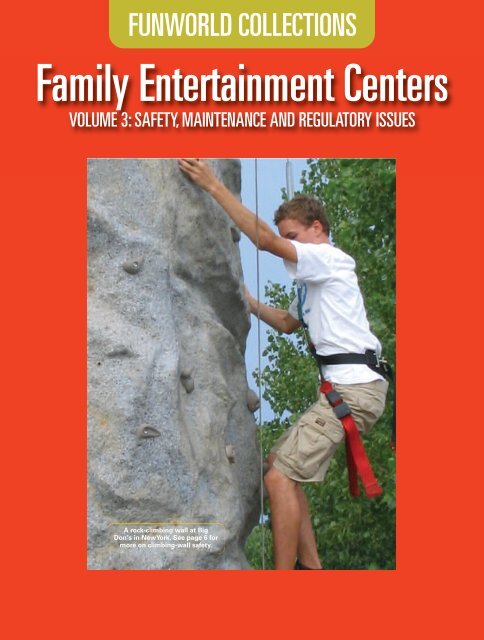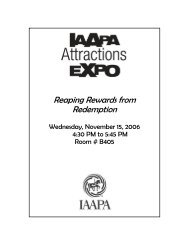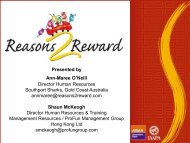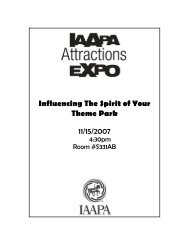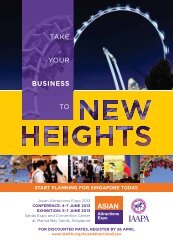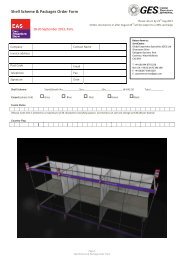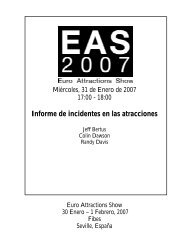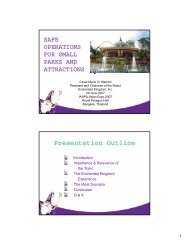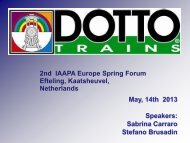Family Entertainment Centers - IAAPA
Family Entertainment Centers - IAAPA
Family Entertainment Centers - IAAPA
Create successful ePaper yourself
Turn your PDF publications into a flip-book with our unique Google optimized e-Paper software.
FUNWORLD COLLECTIONS<br />
<strong>Family</strong> <strong>Entertainment</strong> <strong>Centers</strong><br />
VOLUME 3: SAFETY, MAINTENANCE AND REGULATORY ISSUES<br />
A rock-climbing wall at Big<br />
Don’s in NewYork. See page 6 for<br />
more on climbing-wall safety.
FUNWORLD COLLECTIONS<br />
FECs<br />
VOLUME 3: SAFETY, MAINTENANCE & REGULATORY ISSUES<br />
3 The Price Is Right<br />
FEC operators discuss tips on what to keep on the insurance<br />
checklist and how to use that information as ammunition to get the<br />
best deal.<br />
Originally published in February 2007<br />
4 Jump Around<br />
FEC operators share inflatables dos and don’ts, safety tips, and<br />
planning advice.<br />
Originally published in November 2007<br />
6 Steady as a Rock<br />
FEC operators share their safety tips and precautions when dealing<br />
with rock-climbing walls.<br />
Originally published in January 2008<br />
8 Toy Story<br />
Operators and manufacturers and suppliers discuss recent toy<br />
recalls and how FECs should be educated and aware of the<br />
products they stock.<br />
Originally published in February 2008<br />
10 Preparing for the Worst<br />
FECs discuss best practices for emergency preparedness.<br />
Originally published in June 2008<br />
12 Laying Down the Law<br />
Funworld provides an update on how the CPSC’s Consumer Product<br />
Safety Improvement Act of 2008 will affect FEC operations.<br />
Originally published in January 2009<br />
14 Green Light<br />
Operators share advice and tips on how to ensure a safe go-kart<br />
track.<br />
Originally published in April 2009<br />
16 Up and Running<br />
FEC operators share advice on how to keep old and new games in<br />
top shape.<br />
Originally published in July 2009<br />
18 FEC Safety: Choking Hazards<br />
Originally published in November 2008<br />
The stories contained in this compilation appeared in FUNWORLD magazine from 2007 to 2009.
SPECIAL REPORT<br />
The Price Is Right<br />
FUNWORLD went into the field to ask FEC operators how they shop<br />
around for the best insurance rates and coverage for their facilities<br />
Michael C. Getlan doesn’t struggle when asked how family<br />
entertainment center operators can get the best insurance<br />
rates for their facilities. In fact, living up to his colorful job<br />
title, he barely lets the reporter finish the question. “The<br />
answer to that is very simple: You shop,” says Getlan, director<br />
of enthusiasm and opportunity for Amusement Consultants<br />
Ltd., based in New Rochelle, New York.<br />
He recommends three quotes as a “smart minimum”—a<br />
number echoed by Dorothy E. Lewis, vice president of<br />
marketing for Fun Station Associates in Danbury,<br />
Connecticut.<br />
She also advocates<br />
soliciting all-inclusive<br />
carriers to limit the number<br />
of bills to pay. Certain<br />
insurance companies might<br />
not cover common activities<br />
such as roller skating or<br />
attractions such as<br />
inflatables.<br />
In addition, contact<br />
industry-endorsed vendors<br />
first when doing the allimportant<br />
shopping. “It’s<br />
easier to use someone familiar<br />
with your business,” Lewis<br />
notes. “Others might not have the best knowledge of your<br />
industry and not give you the right coverage.”<br />
There’s no need to reach out to a fly-by-night insurance<br />
company, Getlan adds. The amusement business has enough<br />
reputable, long-standing names that understand the<br />
intricacies and inherent risks of operating a successful FEC.<br />
“We’re already speaking the same language,” he says.<br />
This language, however, may have different dialects.<br />
After filling out numerous pages of paperwork,<br />
Companies X, Y, and Z will each give you a quote. If<br />
Company Z’s figure soars above or dips well below the other<br />
two, take a close, hard look and examine all the details,<br />
Getlan stresses.<br />
Make sure you’re comparing apples to apples, and see<br />
what’s covered and what the exceptions might be, he says,<br />
F.I.R.S.T. Program<br />
<strong>IAAPA</strong> recently announced the debut of an<br />
insurance plan available to FEC members. The<br />
program, called F.I.R.S.T. (FECs, Insurance, Risk<br />
Management, Service, Training), includes the<br />
following: competitive insurance premiums,<br />
premium incentives for facilities with good safety<br />
and risk records, best-practices training, web-based<br />
claims reporting and tracking, on-site safety<br />
inspections and follow-up, plus more. For details,<br />
contact Dave Harris at American Specialty at<br />
+1 260/673-1115 or at dharris@amerspec.com.<br />
by Mike Bederka<br />
because “you can’t have one guy quoting you based on<br />
volume and the other guy on square footage.”<br />
The nature of the attractions and the number of<br />
customers constitute the two biggest factors that go into the<br />
prices a facility receives from vendors, Getlan explains. But,<br />
unlike amusement parks, most FECs are ungated, so<br />
sometimes the insurance companies may work from how<br />
much money you bring in.<br />
He admits, though, it can be a bit of a mystery when you<br />
see the string of numbers that follow the dollar sign.<br />
“For the most part,<br />
insurance is a blind item,”<br />
Getlan says. “You don’t really<br />
know why they come up with<br />
what they come up with.”<br />
However, don’t be afraid to<br />
ask questions if you’re<br />
displeased with the quote.<br />
Everything, to some extent, is<br />
negotiable, he says: “The rate<br />
may not be, but the<br />
conditions or criteria might.”<br />
If you’re struggling with<br />
constantly high and<br />
headache-inducing bills,<br />
Lewis suggests working with<br />
an insurance company that offers a safety and maintenance<br />
program. Some will do inspections to help make sure you’re<br />
running your operation the safest way possible to help<br />
prevent future accidents from occurring. “It’s in their<br />
interest to look at your track record, too,” she says.<br />
Finally, even after you sign a contract, it’s always fair<br />
game to keep looking around at different vendors for any<br />
better deals that may be out there for the cost-conscious<br />
FEC operator, Getlan concludes.<br />
“The wise person is constantly shopping,” he says.<br />
“Complacency is a poor bedfellow. Always keep your ear to<br />
the ground and know what’s going on.”<br />
Keep reading upcoming issues of FUNWORLD for our continuing<br />
coverage of insurance issues for FEC operators.<br />
F E C E d i t i o n n F U NW O R L D C O L L E C T I O N S 3
Jump<br />
Around<br />
by Mike Bederka<br />
With inflatables, family entertainment center owners and operators hope their<br />
profits bounce along with their guests. That’s exactly what’s happening at<br />
Fieldstone <strong>Family</strong> <strong>Entertainment</strong> Center, where a 15-foot slide, part of an interactive<br />
play area for kids, has helped capture an audience too young for go-karts, laser<br />
tag, and many video games.<br />
Chad Hooper, general manager of the<br />
Hiawassee, Georgia-based facility, believes the<br />
attraction has contributed nicely to the FEC’s financial<br />
success. “It’s another piece of the pie,” he says.<br />
“I would hate to see it fail.”<br />
Doing some rough math, he estimates this<br />
play area, including a “foam factory” and inflatable<br />
slide, makes $100,000 in 12 months. “If we<br />
would take it out today,” Hooper says, “I think<br />
we would have a lot of customer complaints and<br />
probably a loss in business.”<br />
But what goes up must come down, and FEC<br />
management needs to be aware of the safety<br />
requirements, additional space, and maintenance<br />
issues that come along with these colorful,<br />
air-filled attractions.<br />
Planning Ahead<br />
Before Fieldstone even broke ground, an inflatable<br />
was in the blueprints. All FECs should try to<br />
have such forethought and have a designated<br />
spot in mind, experts agree.<br />
“You can’t make a spontaneous decision,”<br />
stresses Phil Slaggert, president of Mobile<br />
Midway Safety Institute in Hobe Sound, Florida.<br />
“You can’t just start planning on where to put it<br />
after you buy it.”<br />
Inflatables, whether a slide, obstacle course,<br />
or “moon bounce,” have a large footprint, he<br />
reminds operators. In addition to the inflatable<br />
itself, space for the anchors, inflation tube, and<br />
exits and entrances must be factored in.<br />
Inflatables also have to be far enough away from<br />
other attractions and games in the FEC, so kids<br />
4 F U NW O R L D C O L L E C T I O N S n F E C E d i t i o n<br />
FEC • Inflatables<br />
Inflatables have some<br />
family entertainment<br />
centers bouncing high<br />
Inflatable Rentals<br />
Dos and<br />
Don’ts<br />
An inflatable can run owners thousands<br />
and thousands of dollars, but FECs can<br />
recoup some of those expenses by renting<br />
it out for backyard parties, corporate<br />
functions, or school events. For example,<br />
prices at Moonbounce Adventures<br />
in Pennsylvania start at $225 for the day<br />
and go up from there. “The fancier, the<br />
more expensive it is,” says owner Harry<br />
Bitzberger.<br />
With rentals, though, FEC managers<br />
should be aware of some additional<br />
concerns, says Phil Slaggert, president<br />
of Mobile Midway Safety Institute. They<br />
may need more repairs because of the<br />
frequent set-up and tear-down. That’s<br />
one of the reasons Bitzberger suggests<br />
buying higher-quality inflatables.<br />
Plus, inflatable rentals are subject to<br />
local regulations as well as Consumer<br />
Product Safety Commission jurisdiction<br />
just like any portable amusement ride.<br />
“It’s another layer of regulation they<br />
have to look out for,” Slaggert says.<br />
—Mike Bederka
FEC • Inflatables<br />
don’t bounce into other guests. Harry Bitzberger<br />
follows a general rule when talking about space<br />
allotment with other FEC operators. “If you want<br />
something that’s really cool, it’s going to eat up a<br />
couple hundred square feet,” says the owner of<br />
Moonbounce Adventures, with three<br />
Pennsylvania locations.<br />
Inflatables at <strong>IAAPA</strong> Attractions Expo<br />
For more info on inflatables, check out Phil<br />
Slaggert’s talk this month at <strong>IAAPA</strong><br />
Attractions Expo 2007 in Orlando. The president<br />
of Mobile Midway Safety Institute will<br />
host the Inflatable Insights Vendor Tour on<br />
Thursday, Nov. 15, from 2:30 p.m. to 4:30<br />
p.m. This event will “fast track” attendees to<br />
participating inflatable vendors who will<br />
demonstrate their products’ benefits and<br />
features as well as discuss their service and<br />
finance plans. Participants also will receive a<br />
draft RFP for help in choosing the most<br />
appropriate vendor for their business needs.<br />
To see the full family entertainment center<br />
course track, visit<br />
www.iaapa.org/expos/attractions.<br />
Facilities also must have enough ceiling space,<br />
notes Brian Field, president of Cutting Edge<br />
Creations Inc., an inflatable manufacturer in<br />
Eagan, Minnesota. Heights of 20 to 24 feet<br />
should accommodate most inflatables; anything<br />
less will limit options.<br />
To aid owners with their designs, Cutting Edge<br />
will unveil a layout program at this month’s<br />
<strong>IAAPA</strong> Attractions Expo 2007 in Orlando. This<br />
software will allow attendees to punch in their<br />
room dimensions, along with any center beams,<br />
doors, etc., and with 3-D graphics, they can tell<br />
which inflatables will fit where in a given FEC.<br />
In addition to layout planning, operators must<br />
think early on about staffing issues that may develop.<br />
Laws vary from state to state, but some require<br />
one attendant per unit, Field explains. So even if<br />
four inflatables are all in one room, each one needs<br />
its own employee in the area. “You have to work<br />
that into your business plan,” Slaggert says.<br />
Maintenance and Safety<br />
When considering the particular type of inflatable<br />
to purchase, Slaggert highly recommends<br />
checking to see if the manufacturer and the specific<br />
device are listed on the New Jersey<br />
Department of Consumer Affairs’ web site for<br />
Inflatable Amusement Ride Type Certification<br />
(www.state.nj.us/dca/codes/ridesafetyunit/<br />
ridesafetyunit.shtml). The agency has read the<br />
inflatables’ manuals and reviewed to see if they’re<br />
compliant with ASTM standards for amusement<br />
rides, he says. It also looks at the supplemental<br />
documentation, such as pre-opening inspection<br />
and the maintenance checklist.<br />
“They’re doing a lot of the owners’ work for<br />
them,” Slaggert says. “It’s one of the best consultants<br />
in the business. Do you know why? You<br />
don’t have to pay them.”<br />
He also suggests operators check with their<br />
insurance companies before plunking down the<br />
credit card. Some won’t insure inflatables or will<br />
require a higher premium.<br />
Fortunately, inflatables’ growing popularity<br />
has made it easier to get insurance now compared<br />
to a few years ago, Bitzberger says: “They’re very<br />
safe if they’re utilized appropriately.” That’s why<br />
his staff will instruct all the children and parents<br />
on how to act properly on the equipment; mom<br />
and dad also must stay at the facility. Some of the<br />
most common infractions: tackling (especially<br />
with the older boys) and going down the slide<br />
head first.<br />
“What we like to say when we’re briefing them<br />
early on: ‘If you forget the rules, we’ll come up<br />
and remind you,’” Bitzberger says.<br />
To avoid “an accident waiting to happen,” separate<br />
the kids, if possible, Field suggests. Put the<br />
units that attract the more rambunctious 10- to<br />
12-year-olds in one room; younger children<br />
should go in another. For added safety measures,<br />
Field says, all inflatables should be anchored to<br />
either the floor, the wall, or the rafters. Also,<br />
make sure the equipment is free of wrinkles and<br />
tangles, and follow the manufacturers’ recommendations<br />
on the number of guests allowed in<br />
the unit at one time. He also recommends buying<br />
a safety siren. This will sound if the power supply<br />
to the air blower cuts out, which does happen<br />
occasionally from either a pulled-out cord or a<br />
blown circuit. Some insurance companies offer a<br />
discount if you have a siren, Field notes.<br />
With inflatables, seam fatigue tops the list of<br />
most common maintenance issues. “They’re<br />
being consumed. They’re going to get wear,”<br />
Field says. “The customer has to be realistic.<br />
You’re going to have repairs on these units, and<br />
they should budget for that.”<br />
Hooper agreed about the occasional annoyances<br />
with the material, but for the most part, he<br />
has no complaints about his inflatable. “It really<br />
is a necessity for this environment,” he says.<br />
F E C E d i t i o n n F U NW O R L D C O L L E C T I O N S 5
FEC • SAFETY<br />
Steady as a<br />
Rock<br />
by Mike Bederka<br />
6 F U NW O R L D C O L L E C T I O N S n F E C E d i t i o n<br />
FECs work to keep guests safe<br />
on their climbing walls<br />
What goes up, must come down, of course. The laws of gravity are quite clear on<br />
this. However, family entertainment center operators and staff can delicately<br />
work within these boundaries to ensure their guests have a good time and, more important,<br />
stay safe on their rock-climbing walls.<br />
First off, it’s critical to follow the manufacturer’s<br />
manual regarding repair, maintenance, and parts<br />
replacement, which may vary from company to<br />
company, states the U.S. Consumer Product<br />
Safety Commission. Next, the government agency<br />
A rock-climbing wall at Big Don’s in New York<br />
said facilities must follow these additional key<br />
safety measures:<br />
• Examine auto-belay cables, especially near<br />
pulleys, for wear, broken wires, deformation,<br />
and “fish hooks” (burrs/broken strands of<br />
wire cable).<br />
• Lift or slide the plastic or rubber sheath over<br />
the auto-belay cable on the patron/harness<br />
end and examine for wear, corrosion, broken<br />
wires, and fish hooks. Replace cables if<br />
needed.<br />
• Inspect daily the auto-belay cables for fish<br />
hooks, wear, and corrosion; replace annually<br />
or after 10,000 documented cycles, or earlier<br />
if necessary.<br />
• Examine carabiners, swivels, and rings for<br />
proper functioning and locking; replace if<br />
needed.<br />
• Examine harnesses for wear and tearing and<br />
replace if necessary.<br />
• The maximum recommended weight per<br />
passenger is 250 pounds, or per manufacturer’s<br />
recommendation.<br />
• Make sure the required number of operators<br />
are present.<br />
• Don’t exceed the manufacturer’s requirements<br />
for maximum loads for individual<br />
walls.<br />
As for that last point, Ken Connor of ClubFX<br />
takes some extra precautions. With six stations,<br />
he’ll max out on four climbers for his 23-foot wall.<br />
“We’re climbing kids as young as 5 or 6 years<br />
old,” says the owner of the facility, located in<br />
Mooresville, North Carolina. “They’re not so good<br />
about staying in their lanes. You want to give them<br />
plenty of room. You don’t want them stepping on<br />
each other’s fingers.”
Don Cullen follows a similar strategy. The<br />
owner of Big Don’s Wild River Mini Golf in Cicero,<br />
New York, usually won’t run more than two<br />
people at a time even though he has a 25-foot, fiveclimber<br />
wall.<br />
Cullen also adds another layer of security to his<br />
wall by fencing in the area around it. That keeps<br />
other customers from wandering underneath the<br />
climbers.<br />
Weighty Issues and Staff Training<br />
Staff members at Big Don’s rarely have to deal with<br />
plus-size guests at the wall (240 pounds is the limit<br />
for them), but they must contend with those on the<br />
smaller side.<br />
Kids need to weigh at least 45 pounds. “If they’re<br />
too light they wouldn’t have enough weight to pull<br />
the hydraulic spring-loaded system down,” Cullen<br />
says. “They could get stuck on the wall so to speak.”<br />
Young guests also may get stuck for another reason:<br />
fear of heights. It’s not uncommon for kids to<br />
get halfway up the wall, look down, and then<br />
freeze, says Rocky McIlwain, owner of Fun Zone<br />
Skate Center in Dothan, Alabama.<br />
When that happens, employees calm their skittish<br />
customers, explaining that if they let go, they’ll<br />
be OK.<br />
At ClubFX, staffers also play an active role with<br />
guests, looking for any potential problems. For<br />
example, just because a child meets the weight<br />
requirement (40 pounds), that doesn’t guarantee a<br />
ride up the wall, Connor says. He may be too young<br />
and lack the “situational awareness” to climb.<br />
In those cases, Connor might harness the child<br />
and lift him just a few feet off the ground, letting<br />
him swing around for a little bit.<br />
“They feel like a big kid,” he says. “That’s all<br />
they usually want anyway.”<br />
For the real big kids—those over 200 pounds but<br />
not at the max—Connor suggests a test run. The<br />
rate of descent increases the heavier the person, so<br />
he has them go up seven or eight feet and then<br />
drop. This way, they’ll know what to expect if they<br />
do it for real.<br />
Just in case guests (of any size) fall awkwardly,<br />
there is a four-inch thick gymnastics-type mat to<br />
catch them.<br />
The above situations show why staff preparedness<br />
plays a crucial role with rock wall safety.<br />
Cullen requires new employees to watch a training<br />
DVD, and then they’re shown up close how to<br />
operate the wall. Management observes the first<br />
20 to 30 times they hook up guests and send them<br />
skyward.<br />
An Alternative<br />
Ted Jensen, of Southampton Sports Zone,<br />
Southampton, Pennsylvania, says he doesn’t have<br />
to worry about the typical safety problems with<br />
standard rock walls. Guests on his attraction could<br />
climb 40 to 50 feet but never really get more than<br />
a few feet off the ground.<br />
Jensen’s mechanical wall is a continuous conveyer<br />
belt that goes in a circular pattern; the rocks<br />
are screwed into the stainless steel panels.<br />
A computer controls the level of difficulty, and<br />
guests have 15 different “mountains” to choose<br />
from. A monitor shows how high they’ve climbed.<br />
Customers don’t wear a harness, but the wall has<br />
built-in safety features. Sensors at the top and bottom<br />
shut down the attraction should customers try<br />
to climb over the top or fall off into the foam<br />
padding below.<br />
He bought this wall five years ago because his<br />
ceiling only stands 16 feet tall, limiting his options.<br />
The wall’s footprint is 144 square feet.<br />
“It’s a phenomenal attraction for the amount of<br />
space it takes up,” Jensen says. FW<br />
Mike Bederka is a monthly FUNWORLD contributor. He<br />
can be reached at mbederka@iaapa.org.<br />
FEC • SAFETY<br />
Five Tips to Make Your<br />
Rock Wall Successful<br />
Be sure you have the volume of people to make the<br />
1. wall a sound investment. “A much smaller segment of<br />
the population is going to be more interested than you<br />
think,” says Don Cullen of Big Don’s. For him, young kids<br />
(ages 5 to 13) climb the wall most frequently. Adults and<br />
older teens would rather go elsewhere.<br />
Keep the attraction as visible as possible, says Rocky<br />
2. McIlwain of Fun Zone. Don’t tuck it away in the back<br />
of your FEC.<br />
Always include rock climbing in any birthday party<br />
3. package, says Ken Connor of ClubFX.<br />
Make the wall relatively inexpensive. For two<br />
4. attempts, Cullen charges $4 if it’s the first activity of<br />
the day, $3 if it’s the second. Guests pay $2 a climb at Ted<br />
Jensen’s facility, Southampton Sports Zone.<br />
5. Consider a mobile wall to help expand your audience.<br />
McIlwain plans to bring his second wall to area<br />
schools for fundraisers at no charge. “It puts you in good<br />
standing in the community,” he says. In return, he hopes<br />
the administration will allow his FEC to post flyers around<br />
the school to promote special events.<br />
—Mike Bederka<br />
F E C E d i t i o n n F U NW O R L D C O L L E C T I O N S 7
FEC • TOYS<br />
Toy<br />
Story by Mike Bederka<br />
Easing Worry<br />
Concern grew this past summer when toy giant<br />
Mattel announced some of its products manufactured<br />
in China had dangerous flaws. A Batman<br />
action figure contained a small magnet that could<br />
fall out and be swallowed, and the surface paints on<br />
“Sarge,” a die-cast toy from the movie “Cars,” could<br />
contain lead levels above federal standards. The<br />
company recalled millions of items by year’s end.<br />
Karyn Gitler, a member of <strong>IAAPA</strong>’s FEC committee,<br />
says the scope of the recall as well as whom<br />
it involved came as a surprise to many. “When you<br />
think Mattel, you think Gerber. You think safe,”<br />
says Gitler, director of merchandise at Irving, Texasbased<br />
CEC <strong>Entertainment</strong> Inc. “That just opened<br />
up the floodgates. This could happen to anybody.”<br />
Worried about their children’s well-being, parents<br />
began contacting Chuck E. Cheese’s. Many<br />
8 F U NW O R L D C O L L E C T I O N S n F E C E d i t i o n<br />
<strong>Family</strong> entertainment centers<br />
and redemption suppliers are on<br />
alert following recalls<br />
With almost daily news reports about toy recalls, some parents now may be warily<br />
eyeing the baubles behind an FEC’s redemption counter. Fortunately, leading suppliers<br />
to family entertainment centers say their products remain safe. The headline-grabbing<br />
recalls, however, still impact the FEC industry and stress the importance of<br />
merchandise safety and quality.<br />
Redemption Plus relies on certified<br />
third-party testing facilities that follow<br />
guidelines set forth by the Consumer<br />
Product Safety Commission.<br />
other FECs probably have received similar calls, she<br />
says, and if they haven’t yet, they probably will soon.<br />
Management should handle these conversations,<br />
Gitler advises. Calm any anxieties by walking<br />
customers through your safety process. “We’ve faxed<br />
safety reports to guests to let them know these measures<br />
are in place,” she says. “We want the public to<br />
know safety is a No. 1 priority for us.”<br />
Before FECs purchase any product, they should<br />
ask the vendor for the safety tests done on that piece<br />
and keep copies on file at the facility, she explains.<br />
Tests can vary, depending on the item, but some<br />
include age grading, battery operation, lead content,<br />
flammability, and stuffing cleanliness.<br />
Heightened Scrutiny<br />
For its products, Redemption Plus relies on certified<br />
third-party testing facilities that follow guidelines<br />
set forth by the Consumer Product Safety Commission,<br />
Food and Drug Administration, ATSM International,<br />
and others. The testing takes place before<br />
production, says Darren Wright, vice president of<br />
purchasing. If the merchandise isn’t checked until it<br />
hits the warehouse and then it fails, “we just bought<br />
a bunch of defective goods,” he says.<br />
None of Redemption Plus’ products have been<br />
recalled in this latest wave, but considering current<br />
events, the Lenexa, Kansas, supplier has added<br />
another layer to the inspection process. Redemption<br />
Plus buys some items from other domestic companies<br />
that may import its wares. “In the past, we’ve<br />
simply relied on their testing documents to make<br />
sure the products pass,” Wright says. “Now, we are<br />
requesting an actual copy of those reports to keep in<br />
our own database. This way we are able to address<br />
any customers’ concerns immediately instead of
either passing them along to our vendor or creating<br />
an unwanted delay in getting back to them.”<br />
Sureshot Redemption, of Ontario, California,<br />
has fine-tuned its safety procedures as well, says Mike<br />
Lynch, vice president. (None of its products have<br />
been recalled, either.) In addition to inspections at<br />
factories overseas and the docks, the company has<br />
added more random once-overs to the process.<br />
Time and Money<br />
Even if companies haven’t been directly impacted<br />
by the recalls, they most likely felt the pinch in other<br />
places. Increased inspections and closer product<br />
scrutiny have caused a 2 percent to 4 percent cost<br />
hike, Wright says: “It’s not huge, but when you’re<br />
really watching margins, it makes a difference.”<br />
So the end consumer doesn’t get hit too hard in<br />
the wallet, he tries to offset that expense by lowering<br />
costs elsewhere. However, with some products,<br />
no wiggle room exists and pricing may increase.<br />
Longer lag times are another result of the recalls.<br />
Previously, Wright only needed three months to<br />
receive imported products; it now can take 120 to<br />
160 days. His team members have to select merchandise<br />
a lot sooner in the cycle. As soon as one of<br />
their catalogs comes out, they have to make decisions<br />
about the next. Meaning, slower-selling items<br />
might find their way into multiple catalogs. “It’s kind<br />
of risky,” Wright admits.<br />
A Name You Can Trust<br />
Experts quickly point out that Chinese manufacturers<br />
don’t deserve sole blame for the recalls, and<br />
blindly boycotting all products from the country is a<br />
foolish move, as merchandise from the United<br />
States and Europe gets recalled as well. “You just<br />
don’t see the same press or publicity generated,”<br />
Wright says.<br />
Generally speaking, the media have blown some<br />
aspects of the recalls out of proportion, Gitler says:<br />
“People shouldn’t be afraid of every toy. They<br />
shouldn’t be afraid of anything with paint on it.<br />
These were just a few of the extremes.”<br />
Still, safety is a serious issue, she says, and the<br />
industry must continue to be vigilant. “Look for<br />
companies that have a track record, have a history,”<br />
Lynch says. “A lot of places pop up and then disappear.”<br />
FW<br />
Mike Bederka is a contributing writer for FUNWORLD. He<br />
can be reached at mbederka@iaapa.org.<br />
FEC • TOYS<br />
F E C E d i t i o n n F U NW O R L D C O L L E C T I O N S 9
David Novstrup, co-owner/<br />
general manager of<br />
Thunder Road in<br />
Aberdeen, South Dakota<br />
FEC: PLANNING<br />
Preparing for<br />
the Worst<br />
FECs should have policies in place<br />
for any emergency<br />
by Mike Bederka<br />
BE IT A FIRE, FISTFIGHT, OR FLOOD, emergencies will<br />
pop up if you operate a business long enough. Luckily, a calm<br />
head, proactive attitude, and established policies and procedures<br />
should allow most family entertainment centers to<br />
avert disaster.<br />
Here’s how some facilities prepare for the worst.<br />
A Lost Child<br />
When a child goes missing, parents panic. The staff at Fun<br />
Expedition in Johnson City, Tennessee, understands how scary<br />
that feeling can be.<br />
As soon as Mom or Dad reports a lost child, the FEC goes<br />
into “Operation Safe” mode, explains<br />
Alan Kumpf, general manager. An allpage<br />
announces the situation, and the<br />
whole building locks down—nobody<br />
can go in or out. “All employees leave<br />
their station no matter what they’re<br />
doing,” he says. “They have a responsibility<br />
to fulfill.”<br />
Some staff will cover exits; others,<br />
armed with a description given by the parent,<br />
roam the premises, looking for the<br />
10 F U NW O R L D C O L L E C T I O N S n F E C E d i t i o n<br />
young guest. It hasn’t taken longer than five and a half minutes<br />
to find a child, Kumpf says proudly. They go into “Operation<br />
Safe” about three or four times a week—often due to parents<br />
letting their children wander away.<br />
Weather Woes<br />
All FECs can vouch for how important weather is in their<br />
business. Usually, rain clouds just dictate how busy they’ll be.<br />
But what if something more serious looms on the horizon,<br />
like a tornado or a flash flood?<br />
David Novstrup believes he has an edge. The coowner/general<br />
manager of Thunder Road in Aberdeen,<br />
South Dakota, has taken several storm spotter training classes<br />
through the National Weather Service.<br />
Now, he always keeps a close watch on the web site of a local<br />
weather station. By looking at the storm shape and how it<br />
moves, Novstrup has a good idea about where hail, tornados, or<br />
straight-line winds will develop. He also knows when the<br />
umbrellas and chairs should be put away as well as when guests<br />
should probably head home for safety reasons. “It’s a more scientific<br />
way to look at things,” Novstrup says. “It’s not just a gut<br />
feeling.”<br />
Emergency Call Center Available<br />
American Specialty offers a crisis response product that can be included as<br />
part of the <strong>IAAPA</strong> FEC Insurance Program. With this product, an FEC can<br />
have 24-hour access to an emergency call center that can handle up to<br />
3,000 calls per hour from concerned family, friends, and media outlets.<br />
Phones are manned by mental health professionals specifically trained<br />
to handle crisis situations. The product includes an insurance component<br />
to provide payment if the phone center is activated.<br />
For more info, call American Specialty at +1 260/672-8800 or e-mail amerspec@amerspec.com.
Handling a Holdup<br />
Crime is an unfortunate reality of<br />
operating a cash business. To help<br />
avoid any serious situations, always<br />
have two people closing, advises<br />
John Sarantakis, owner of The People’s<br />
Choice <strong>Family</strong> Fun Center,<br />
with a pair of Illinois locations.<br />
Also, lock the doors when the<br />
last customers leave, he says, and<br />
keep an eye on any suspicious-looking<br />
people and vehicles outside. If<br />
someone does attempt to rob your<br />
FEC, make sure staff knows to give<br />
the crook all the money, notes<br />
Edward Mainardi Jr., owner of Laser<br />
One in Wantage, New Jersey. “You<br />
have a couple hundred dollars in the<br />
drawer,” he says. “It’s not worth<br />
someone getting hurt over.”<br />
“Don’t hesitate,” Sarantakis adds. “We’re insured for that<br />
kind of stuff.”<br />
Fire Emergencies<br />
When the fire alarm blares, it’s often a mischievous child just<br />
pulling the lever. But sometimes the concern is real.<br />
Sarantakis had a game where one of the chips started to<br />
burn inside. Smoke poured out, and a harsh smell emanated.<br />
In this case, just unplugging the machine fixed the problem—<br />
a fact they quickly realized. “You want to get someone to the<br />
situation right away to see what’s going on and resolve the<br />
matter,” he says. “You don’t want people to panic. You don’t<br />
want to put anyone in jeopardy.”<br />
Novstrup had an incident where a staff member overfilled<br />
the tank on one of the go-karts. The ethanol spillover was<br />
coming awfully close to the chlorine tank for the bumper<br />
boats. He called the fire department right away. “We didn’t<br />
want to take a chance that something bad would happen,”<br />
Novstrup says.<br />
FEC: PLANNING<br />
Detailed Response Plan Needed<br />
During an emergency, FECs should have a response plan where each individual,<br />
position, or department has a clear role, says Rich Powers, vice president<br />
of risk services for American Specialty, a Roanoke, Indiana-based program<br />
underwriter.<br />
While it’s impossible to address every scenario that might occur, Powers<br />
says, at a minimum, facilities should have separate, detailed, and readily<br />
accessible plans for the following:<br />
• park evacuation (including assisting guests with disabilities)<br />
• ride/attraction evacuation<br />
• severe weather<br />
• bomb threat<br />
• medical emergency (injury and illness)<br />
• missing children<br />
• fire.<br />
By the end of the year, American Specialty will have educational materials<br />
available online to allow FECs to build their own crisis and emergency plan.<br />
<strong>Family</strong> Disputes<br />
On occasion, Sarantakis has had people come to blows in his<br />
facilities; usually, it involves ex-husbands, current boyfriends,<br />
and the like. He tries to step in and diffuse any situation<br />
before it turns physical; Sarantakis doesn’t allow profanity,<br />
and he has no problem calling the police when people get out<br />
of control.<br />
Kumpf also relies on the police, but he has them on his<br />
payroll. A uniformed officer patrols his location during the<br />
busy times in hopes of preventing of any disturbances among<br />
customers. “It does nip a lot of that stuff in the bud,” he says.<br />
“The visibility of a police officer on site changes people’s<br />
mind-set.”<br />
It’s a serious expense, but the security it provides offsets<br />
the cost. “People feel safe when they come to our location,”<br />
Kumpf says. “That’s important. You can’t put a dollar amount<br />
on that.” FW<br />
Mike Bederka is a contributing editor for FUNWORLD. He can be<br />
reached at mbederka@<strong>IAAPA</strong>.org.<br />
F E C E d i t i o n n F U NW O R L D C O L L E C T I O N S 11
FEC: SAFETY<br />
Laying Down<br />
the Law<br />
How the Consumer Product Safety<br />
Improvement Act affects FECs and<br />
the industry at large<br />
by Mike Bederka<br />
THE CONSUMER PRODUCT SAFETY IMPROVE-<br />
MENT ACT OF 2008 will change how family entertainment<br />
centers and other attractions, as well as redemption companies,<br />
operate, regardless of the operation’s size or volume.<br />
“There’s a bit of apathy out there, (especially with singlelocation<br />
facilities),” says Jerry Venner, director of Fun Express<br />
Inc., an Omaha, Nebraska-based redemption supplier. “People<br />
think this is just a Wal-Mart, Toys ‘R’ Us, Chuck E.<br />
Cheese-kind of legislation. No, this actually applies to you.”<br />
Here are some highlights.<br />
Lower Lead Levels<br />
By Feb. 10, 2009, items designed or intended primarily for<br />
children age 12 and younger may not contain more than 600<br />
parts per million (ppm) of lead. At the time of taking this<br />
article to press, the CPSC’s general counsel has taken the<br />
position that existing inventory cannot be sold after this date,<br />
unless it complies with the new lead limits.<br />
One year from enactment—Aug. 14, 2009—these products<br />
cannot contain more than 300 ppm of lead; the limit<br />
goes down to 100 ppm after Aug. 14, 2011, unless the U.S.<br />
Consumer Product Safety Commission (CPSC) determines<br />
that it’s “not technologically feasible.”<br />
Some children’s products may be exempted or excused<br />
from these new limits if a component part containing lead is<br />
inaccessible.<br />
In addition, after Aug. 14, 2009, the act states that paint<br />
and similar surface-coating materials must be reduced from<br />
600 ppm to 90 ppm of lead.<br />
Third-Party Testing<br />
The legislation imposes an additional third-party testing<br />
requirement for all products primarily intended for kids 12<br />
and younger. Every manufacturer (including an importer) or<br />
private labeler must have its product tested by an accredited<br />
independent lab and, based on the testing, issue a certificate<br />
that the product meets all applicable CPSC requirements.<br />
Certificates must include info on the identity of the product’s<br />
12 F U NW O R L D C O L L E C T I O N S n F E C E d i t i o n<br />
manufacturer/private labeler, the testing lab, and the date<br />
and place of manufacturing and testing of the product. Products<br />
without the certificate cannot be imported or distributed<br />
in the United States.<br />
The third-party testing/certification requirements are<br />
phased in on a rolling schedule. For example, “small parts” is<br />
February 2009 and 300 ppm lead content is August 2009.<br />
Tracking Labels<br />
The new law requires manufacturers to have a tracking label<br />
or other distinguishing permanent mark on any consumer<br />
product primarily intended for children 12 and younger.<br />
The tracking label must contain certain basic information:<br />
the source of the product, the date of manufacture, and<br />
more detailed info on the manufacturing process like a<br />
batch or run number. This requirement goes into effect after<br />
Aug. 14, 2009.<br />
Nixing Phthalates<br />
As of Feb. 10, 2009, it will be illegal to manufacture, sell, distribute,<br />
or import into the United States any children’s toy<br />
that contains concentrations of more than 0.1 percent of di-<br />
(2-ethylhexyl) phthalate (DEHP), dibutyl phthalate (DBP),<br />
or benzyl butyl phthalate (BBP).<br />
There’s also an “interim prohibition,” beginning Feb. 10,<br />
2009, on any toy that can be placed in a child’s mouth that<br />
contains concentrations of more than 0.1 percent of<br />
diisononyl phthalate (DINP), diisodecyl phthalate (DIDP),<br />
or di-n-octyl phthalate (DnOP).<br />
Phthalates, used widely as plasticizers and solvents, appear<br />
in many products, including building materials, personal care<br />
products, medical devices, and toys, according to the<br />
American Council on Science and Health.<br />
The CPSC’s general counsel has written an advisory<br />
opinion that says Congress did not indicate in the law that<br />
the phthalates ban applies retroactively. Unless Congress or<br />
the CPSC commissioners reverse this opinion, existing<br />
inventory is not covered by the ban.<br />
How to Respond<br />
As a result of the law, FEC owners and operators will now<br />
have more duties and obligations placed upon them, notes R.<br />
Wayne Pierce, a counselor with the Pierce Law Firm LLC, in<br />
Annapolis, Maryland. “Folks need a process on how they’re<br />
going to respond.”<br />
Venner offers some tips and general advice on working<br />
with vendors:<br />
� The supplier (importer) should be named on the report<br />
as the party requesting the testing, not just the manufacturer.<br />
Expect the supplier may not reveal proprietary<br />
information on the report (like the production factory<br />
name and address).
� Safety reports should be available upon request. “If [an<br />
FEC] can’t get that back in 48 hours, you have a problem,”<br />
Venner says.<br />
� The test report should be dated in the past 12 months<br />
or at least done in conjunction with the last shipment<br />
of the item produced for the supplier.<br />
� Testing must be done by an accredited independent<br />
third-party consumer products lab to all applicable<br />
requirements.<br />
� The test report must have a detailed description of the<br />
item, the tests performed, and a photo of the samples is<br />
strongly recommended.<br />
“FECs should feel empowered to be able to ask for this<br />
information,” says Kevin Klein, sales manager of amusement/redemption<br />
for Fun Express.<br />
Serious Ramifications<br />
The government offers some tough talk for failure to<br />
follow the new law, including “significant civil and criminal<br />
liability.”<br />
“Realistically, is some guy going to show up in a dark suit<br />
Costs to<br />
Increase<br />
FEC: SAFETY<br />
Add another consequence from the act: FECs can<br />
expect to pay more for merchandise.<br />
“There is just no other way to say it,” explains<br />
Jerry Venner of Fun Express Inc. “There is a financial<br />
impact. Many of the substitute chemicals required to<br />
meet the new guidelines are simply more expensive.<br />
It will drive some cost increases.”<br />
and sunglasses with an AK-47 and ask, ‘Are you compliant?’”<br />
Venner comments. “I don’t think it’s going to look<br />
like that.” Rather, he believes reckless FECs will come<br />
under the watchful eye of passionate consumer advocacy<br />
groups and those in the legal community.<br />
The subsequent loss of customers and money, and the generation<br />
of negative press will be damaging. “You don’t want<br />
to be the lead story on the five o’clock news,” Venner says.<br />
As this issue develops, please stay tuned to the <strong>IAAPA</strong> FEC<br />
web page at www.<strong>IAAPA</strong>.org/community/fec, the <strong>IAAPA</strong><br />
blog at www.<strong>IAAPA</strong>.org/blog, and FUNWORLD for further<br />
updates. For more information on the Consumer Product<br />
Safety Improvement Act of 2008, visit www.cpsc.gov/<br />
ABOUT/Cpsia/cpsia or call +1 301/504-7923. FW<br />
F E C E d i t i o n n F U NW O R L D C O L L E C T I O N S 13
FEC: SAFETY<br />
Green Light<br />
FECs keep guests safe on the<br />
go-kart track<br />
by Mike Bederka<br />
A LITTLE OVER DECADE AGO, Don Woodward brought<br />
his son around to area family entertainment centers to scope<br />
out the competition and glean some ideas for his facility<br />
being constructed.<br />
While doing reconnaissance at one place, he saw an<br />
ambulance and fire engine roar up to the go-kart track. A bad<br />
accident had occurred and a car burst into flames.<br />
No way, Woodward thought, would either he or his son<br />
ever buckle up there.<br />
That incident has stuck with him and it serves as an<br />
important reminder when it comes to go-karts and overall<br />
FEC operation.<br />
“If you have an unsafe park, it’s going to go bankrupt<br />
pretty quickly,” says Woodward, safety director of Adventure<br />
Zone Inc. in Geneva-on-the-Lake, Ohio. He also serves on<br />
the state’s Ride Safety Advisory Council.<br />
Training and Equipment Checks<br />
Having safe go-karts starts with the staff running them,<br />
Woodward says. Operators should screen their employees and<br />
look for certain personality traits like being attentive and<br />
authoritative, especially in cases where guests don’t follow<br />
the rules.<br />
Once hired, folks at Neb’s Funworld in Oshawa, Ontario,<br />
14 F U NW O R L D C O L L E C T I O N S n F E C E d i t i o n<br />
Go-kart track at<br />
Adventure Zone<br />
in Ohio<br />
Canada, must study a specially created in-house manual on<br />
go-karts and pass a written test, explains owner Tom England.<br />
Managers quiz them on height requirements, payment, seat<br />
belts, how the car works, hair safety, helmets, and more.<br />
The ultimate goal is to have all staff “singing the same<br />
song” when interacting with customers, England says. “I don’t<br />
want, ‘Go when Bill is working. He’ll let us do whatever we<br />
want.’”<br />
As part of the training process and to further strengthen<br />
the venue’s ideals, rookie go-kart staffers start as helpers.<br />
They move up the cars, get people through the queue, and<br />
assist on the track with spinouts. Lead hands, a more senior<br />
position, run the race.<br />
Like all rides and attractions, go-karts and the track should<br />
undergo strict testing to make sure they pass inspection. Staff,<br />
of course, play a vital role here as well.<br />
Adventure Zone employees must review detailed daily<br />
checklists. Go-karts undergo a complete evaluation, including<br />
the gas cap, seat belt, fluid levels, tires, brakes, and fiberglass.<br />
With the track, for example, staff look for debris and holes,<br />
test the functionality of the traffic lights, and examine the<br />
security perimeter fence and rails.<br />
The track's barrier, a five-inch high steel band mounted to<br />
15-inch tires, prevents injuries by its strong resilience and<br />
impact absorption, Woodward says: “It’s heavy enough that it<br />
won’t jump up when hit, and it doesn’t allow the cars to climb<br />
over it.”<br />
Preventing Injuries<br />
Despite all the best intentions and precautions, crashes and<br />
injuries still can crop up, says Royce Stine, financial controller<br />
for Mesa Golfland Sunsplash in Mesa, Arizona. Bruises<br />
sometimes result when one car whips around another or a
person doesn’t take a curve quite right.<br />
In those situations, the go-kart’s emergency<br />
cutoff system can help big time, he says.<br />
The kill switch allows the FEC to turn off<br />
one, several, or all of the cars to sort through<br />
the mess.<br />
When one go-kart spins out, another will<br />
surely follow, particularly on a busy night,<br />
Woodward agrees.<br />
“You have to shut down that track,” he<br />
notes, “and if you don’t have a fail-safe system,<br />
you’re going to have problems.”<br />
England attributes the “NASCAR bumpand-grind<br />
mentality” as another common<br />
issue and cause of injuries.<br />
At Adventure Zone, guests acting like<br />
Jimmie Johnson will be kicked off with no<br />
refund. “These are go-karts, not bumper<br />
karts,” Woodward says. “We have zero tolerance.”<br />
England also has strong feelings about<br />
aggressive driving and used some creative<br />
means as a solution. He installed pressuresensitive<br />
bumpers on all go-karts. If a driver<br />
hits another car, the guest is automatically<br />
slapped with a 10-second slow down penalty.<br />
“We wanted to get away from having to<br />
say ‘no’ to customers,” says England, who has<br />
R&D experience. “The car polices itself.<br />
When you drive like a moron, you get a<br />
penalty. They now have to drive strategically.”<br />
His innovation hasn’t drawn the ire of any<br />
speed demons. In fact, just the opposite happened.<br />
“No one has come up to me and said I hate<br />
this place because it has pressure-sensitive<br />
bumpers,” he says. “Parents tell me they love<br />
bringing their kids here. It’s the only place<br />
they [feel] safe.” FW<br />
For information about the <strong>IAAPA</strong>-sponsored<br />
FEC insurance program and go-kart safety,<br />
please visit www.amerspec.com, or call +1<br />
800/245-2744.<br />
FEC: SAFETY<br />
10 Tips for Loss Prevention<br />
1. Reference Materials. Obtain a copy of ASTM F2007-07a<br />
(www.astm.org/Standards/F2007), the most current standard for<br />
go-kart track operation. Also, follow recommendations, guidelines,<br />
and restrictions provided by the go-kart manufacturers.<br />
2. Fire Safety. Prominently place extinguishers in the pit area and<br />
around the track. Designated refueling station should be away from<br />
patrons.<br />
3. Secure Perimeter. Have self-closing and latching access gates at<br />
pit entrance and exits points. In addition, there should be complete<br />
perimeter fencing.<br />
4. Participant Communication. Post safety, warning, restriction,<br />
and rule signage at the entrance to the queue and in the pit.<br />
Some FECs have guests sign waiver and release forms prior to participating.<br />
These documents can be a valuable tool to defend<br />
against a lawsuit claiming damages because of an injury. Rules<br />
also should be provided on an audible loop so guests can hear<br />
instruction while in line. Finally, as attendants buckle in customers,<br />
they can any answer additional questions.<br />
5. Guest Safety. Each customer must pass all restrictions prior to<br />
participation. Facilities should provide a helmet to guests who want<br />
one.<br />
6. Staffing. Ensure customers are secured and understand all rules;<br />
control guests as they exit the pit area and enter the track; observe<br />
all areas of the active track during race operations; control participants<br />
entering the pit area when their time is up; and keep people<br />
seated and secured until all customers have entered and<br />
stopped their go-karts in the pits.<br />
7. Inspections. Complete and retain daily documented safety<br />
inspections prior to opening for public operations covering the following:<br />
Inspect condition of each car (frame, body, tires, driver’s<br />
compartment, safety equipment, gas cap/tank), and test drive prior<br />
to putting into service. Check condition of fencing and gates, and<br />
ensure signage and audible instruction loops are in place, readable,<br />
and in working order.<br />
8. Maintenance. Complete documented maintenance including: all<br />
preventive maintenance and repairs; annual inspection, service,<br />
and maintenance of extinguishers from an outside fire<br />
services contractor; and all track surface/markings, bump rail, and<br />
fencing repairs.<br />
9. Training. Complete documented training of all operations and<br />
maintenance staff including the completion of inspections; maintenance<br />
responsibilities; standard operating procedures; and emergency<br />
and incident response procedures in case of injury, severe<br />
weather, etc.<br />
10.Supervision. Oversee amusement area to provide assistance to<br />
employees and guests as needed; monitor, audit, and<br />
improve employee behavior/performance; and enforce park rules.<br />
Source: Russ Kietzman, assistant vice president in the loss control department for American Specialty<br />
Insurance and Risk Services in Roanoke, Indiana<br />
F E C E d i t i o n n F U NW O R L D C O L L E C T I O N S 15
SAFETY & MAINTENANCE<br />
FEC: SAFETY & MAINTENANCE<br />
Up and Running<br />
Maintenance crews keep FEC game<br />
rooms in check<br />
by Mike Bederka<br />
IF IT CAN BEEP, BLINK, FLIP, PUSH, OR SPIN in a family<br />
entertainment center’s game room, it can probably break.<br />
Out of order signs = lost revenue + annoyed guests. Mike<br />
Cappella knows the equation well. “I was always taught to<br />
never let a customer complaint get out of your building,” says<br />
the director of building maintenance at Sports Plus in<br />
Cincinnati, Ohio. “Do whatever it takes to make them<br />
happy.”<br />
To avoid bad word of mouth (the nemesis of all attractions),<br />
people like Cappella stay busy. They constantly plan,<br />
tinker, and fix to keep their prized game floors running<br />
smoothly.<br />
New vs. Used<br />
Cappella’s facility features roughly 125 games—many of<br />
them 10 to 15 years old. The price tag on newer games makes<br />
Sports Plus’ management think twice about these larger purchases,<br />
he says. The most common issues for the older games<br />
include ticket jams, broken switches, and busted buttons from<br />
the constant pounding, Cappella says.<br />
Game technician Scott Wise also has replaced a fair number<br />
of buttons in his two years at Rascal’s Food and Fun. The<br />
16 F U NW O R L D C O L L E C T I O N S n F E C E d i t i o n<br />
Rascal’s<br />
Allentown, Pennsylvania, FEC owns about 60 games, a mix<br />
of new and reconditioned.<br />
“In hindsight, we should have bought more new games,”<br />
acknowledges Rascal’s operations manager, Geoff Spitko, citing<br />
fewer maintenance issues and a better warranty.<br />
Cappella agrees newer games boast a big advantage: “They<br />
have one board instead of five. Those are easier to work on<br />
because you’re not going through 10 different steps to find<br />
one problem.”<br />
But don’t be so quick to toss the vintage “Pac-Man” to the<br />
curb, cautions Harvey Wells, maintenance supervisor at Party<br />
Central in Bossier City, Louisiana: “New games are just as apt<br />
to break as old ones.”<br />
Maintenance Protocols<br />
Party Central relies on Wells to solve most mechanical problems.<br />
Frontline staffers only have the authority to clear coin<br />
jams, put in tickets, and turn on and off the games, he says.<br />
He designates one employee to work the arcade floor and<br />
look for glitches, and that person gives Wells a complete<br />
write-up of all issues to expedite the process. For the experienced<br />
technician, most fixes take only five minutes.<br />
Rascal’s follows a similar protocol, where employees just<br />
handle simple jams and cleaning. Before they close for the<br />
night, staff will compile a maintenance log, Spitko says. Wise<br />
arrives at 7 a.m. and gets to work on the jobs. “By the time<br />
the doors swing open at 11 a.m., we’re rolling,” Spitko says.<br />
Managers also should rely on their card reader system to<br />
troubleshoot, Cappella says. Examining the revenues can<br />
reveal problems previously undetected. For instance, pay<br />
attention if one game normally brings in $100 a day and<br />
RASCAL’S
suddenly drops to $25. “That raises a red flag,” he<br />
says. “Let me check it out. Is something not working?<br />
Or did we have a slow day?”<br />
Stocking Up<br />
Regular upkeep plays a big part in ensuring games<br />
stay in tiptop shape. “If it turns, keep it lubricated,”<br />
Wise says. “And always keep the games clean. Dust<br />
does a number on the wiring.” At Rascal’s, all<br />
games get wiped down on the outside at least daily,<br />
and he vacuums the insides once a week.<br />
Smart operators also stock up on frequently<br />
used parts, Wise says. They have a running inventory<br />
of buttons, power supplies, and fuses. “If it’s a<br />
hot game, we have to get it running,” Spitko says.<br />
Above anything else, Wise wants to make sure all<br />
games are A-OK by the weekend. “If I can’t do that, it’s really<br />
frustrating,” he says. “But there’s not much I can do if I don’t<br />
have the part.”<br />
Seventy-five percent of the time, Wells has the item<br />
needed to fix a problem; when he requires a pesky or hard-toget<br />
part, he’ll usually order two of them to lessen future downtime.<br />
Sometimes, though, parts for older games just don’t<br />
exist anymore. That’s when Wells’ 25 years of experience in<br />
electronics comes in handy. “You’re going to be lucky if you<br />
FEC: SAFETY & MAINTENANCE<br />
Handling Guests<br />
When a game inevitably breaks and a customer inevitably<br />
becomes annoyed, staff must always remain calm. “That’s one<br />
of the biggest things I teach my managers and staff,” says Mike<br />
Cappella of Sports Plus.<br />
FEC employees should do their best to explain the problem<br />
and how soon it will be repaired, adds Geoff Spitko, from<br />
Rascal’s Food and Fun. “You just have to be honest,” he says.<br />
“Explain we have a guy looking at it. We just ordered parts. I’ll<br />
even name the part, if I know it.”<br />
Also, refer the guest to a game that’s similar to the broken<br />
one, Spitko says.<br />
have a manual,” he notes. “You end up having to somehow<br />
fix it yourself. I’ve had to reengineer a couple games.”<br />
Despite a technician's aptitude, some games may not be<br />
worth salvaging, Cappella says. Again, management should<br />
keep a close eye on the money going into and out of a<br />
machine.<br />
“Look at what it’s costing you on a day-to-day operation,”<br />
Cappella says. “Is the revenue really there to keep this<br />
game up and running? Or is it just five kids who play it?” FW<br />
F E C E d i t i o n n F U NW O R L D C O L L E C T I O N S 17
SPECIAL REPORT: FEC Safety<br />
Choking Hazard<br />
Protecting young guests from harm<br />
by Mike Bederka<br />
MICHAEL GETLAN IS ON A CRUSADE. He wants all<br />
toys that could possibly be a choking hazard removed from<br />
redemption centers and bulk vendors.<br />
He compares offering young guests dangerous items, like<br />
a 27-millimeter ball, to operating an unsafe ride or attraction.<br />
“What’s the difference?” asks Getlan, director of enthusiasm<br />
and opportunity for Amusement Consultants Ltd. in New<br />
Rochelle, New York.<br />
His mission has a history. About two decades ago, a 3year-old<br />
boy died from choking on a toy that his older<br />
brother got at Getlan’s family entertainment center. “We<br />
were completely devastated and emotionally shocked,” he<br />
says. Because of the incident, Getlan removed all choking<br />
hazards from his facilities.<br />
But as time passed and managers changed, those items<br />
slowly crept back into the redemption areas. Again, Getlan<br />
cleaned house, and now he has contacted others in the<br />
industry to help him with his campaign, including merchandise<br />
companies, and bulk vending, trade, and equipment<br />
manufacturers associations.<br />
“The real issue is to remove these things from circulation,”<br />
he says. “I’m taking a strong stance. I don’t want anything<br />
like that in our facilities.”<br />
Taking Precautions<br />
While many small items still remain available for purchase,<br />
buyers at FECs must remain vigilant.<br />
“A lot of times, the prizes have been taken for granted,”<br />
says Karyn Gitler, director of merchandise for Irving, Texasbased<br />
CEC <strong>Entertainment</strong> Inc. “The facility didn’t have<br />
someone focus on it. That’s a mistake.<br />
“Each piece has to be looked at individually to decide<br />
what is appropriate for their facility,” adds Gitler, a member<br />
of the <strong>IAAPA</strong> FEC Committee. “Choking is an important<br />
issue, but it’s one of many out there today.”<br />
To properly check their merchandise, all FECs should<br />
own a Choke Tester, Getlan notes. If an object fits entirely<br />
inside this plastic tube, then it’s considered a choking hazard<br />
for children under age 3, according to the United States<br />
Consumer Product Safety Commission (CPSC). (The company<br />
Perfectly Safe in North Canton, Ohio, +1 800/898-<br />
3696, sells the tester for $2.95. The sales representatives for<br />
Fun Express, an Omaha, Nebraska, redemption supplier carry<br />
them as well.) Getlan has the choke tube right on his counter<br />
18 F U NW O R L D C O L L E C T I O N S n F E C E d i t i o n<br />
when he does ordering.<br />
“Our reps make sure they’re educated on all the safety legislation<br />
that’s in play, and they have the tools to work with<br />
our FECs,” says Kevin Klein, sales manager for amusement/redemption<br />
at Fun Express. “We consult with them to<br />
understand better who their target customer is, and then we<br />
try to bring in merchandise that’s in line with their audience.<br />
We have more than 10,000 items to choose from. We have<br />
a good opportunity to find replacement items that may not<br />
cause as much of a concern from a choking standpoint.”<br />
The Fun Express redemption catalogue indicates what<br />
items might not be appropriate for certain age ranges, and the<br />
company follows all the guidelines outlined by the CPSC,<br />
explains director Jerry Venner: “Every single package of products<br />
we ship out the door has the appropriate age-grade warning<br />
label.”<br />
Due Diligence<br />
Venner wants facilities to use caution when buying their merchandise.<br />
“Shame on me, if I’m an FEC owner or manager<br />
and I have not done any due diligence to ask some questions<br />
to make sure my vendor is not asleep at the wheel,” he says.<br />
Ask questions about the product testing and demand an<br />
actual copy of the test report (with a picture of the item)—<br />
not a 7-year-old, fifth-generation photocopy, he says. The<br />
report must be done by an independent third-party lab from<br />
at least the past 12 to 18 months, and vendors should provide<br />
the report in four days or less.<br />
Venner also urges FEC management to be leery of the<br />
wheeling-and-dealing types who offer closeout or liquidation<br />
merchandise. “It’s important that someone doesn’t get<br />
sucked into the attractiveness of, ‘Boy, that’s half the price of<br />
what I’m paying now,’” he says. “It might turn out to be 75<br />
percent lead or it might be a rejected shipment because it<br />
wasn’t labeled right and contained small parts.”<br />
However, keep in mind that even with all the precautions<br />
taken by vendors and facilities, accidents still can happen,<br />
Venner says. For example, a 50-pound kid could jump on an<br />
all-ages toy and breaks it into small parts, or as described<br />
above, an older brother can give a 3-and-up item to a<br />
younger sibling.<br />
“Then, the best-laid plans went out the window,” Venner<br />
says. “But clearly, we’re going to take incredible steps. We all<br />
have the responsibility to hold each other accountable.” FW


